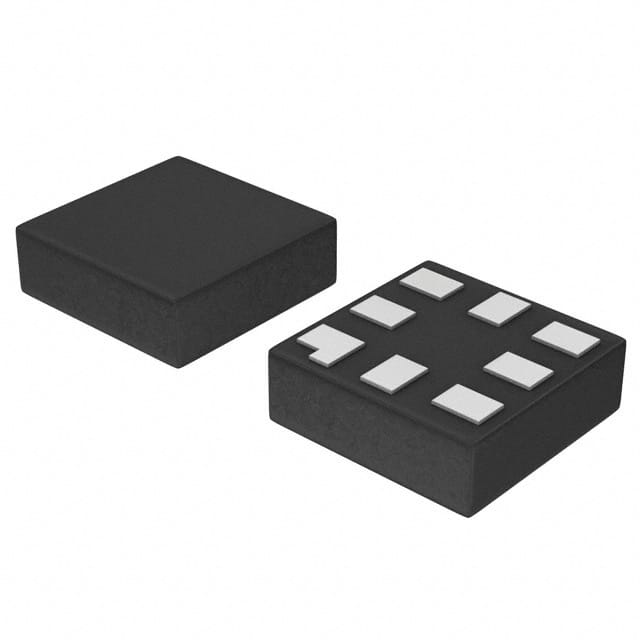Siehe Spezifikationen für Produktdetails.

PCA9306AMUTCG
Product Overview
- Category: Integrated Circuit
- Use: Level Translator
- Characteristics: Bidirectional, I2C-Compatible, Voltage-Level Shifter
- Package: SOT23-5
- Essence: Efficient voltage translation between different logic levels
- Packaging/Quantity: Tape and Reel, 3000 units per reel
Specifications
- Supply Voltage: 1.2V to 3.6V
- Logic Voltage Levels: 1.2V to 3.6V
- Maximum Data Rate: 400kHz
- Operating Temperature Range: -40°C to +85°C
Detailed Pin Configuration
The PCA9306AMUTCG has a total of 5 pins:
- A-side Voltage Supply (VCCA)
- B-side Voltage Supply (VCCB)
- A-side I/O (SDA)
- B-side I/O (SCL)
- Enable Input (EN)
Functional Features
- Bidirectional voltage-level shifting between two I2C buses with different voltage levels.
- Compatible with I2C Fast Mode and Standard Mode.
- Automatic direction sensing eliminates the need for a direction control pin.
- Low standby current consumption, suitable for battery-powered applications.
Advantages
- Simplifies interfacing between devices operating at different voltage levels.
- Eliminates the need for additional level-shifting components.
- Supports bidirectional communication without requiring external control signals.
- Low power consumption extends battery life in portable devices.
Disadvantages
- Limited to I2C bus applications only.
- Maximum data rate is limited to 400kHz.
- Not suitable for applications requiring voltage translation beyond 3.6V.
Working Principles
The PCA9306AMUTCG utilizes a level-shifting circuit to translate voltage levels between two I2C buses. It automatically detects the direction of data flow and adjusts the voltage levels accordingly. The device operates by monitoring the voltage levels on both sides and switching the internal FETs to provide bidirectional translation.
Detailed Application Field Plans
The PCA9306AMUTCG is commonly used in various applications, including:
- Interfacing low-voltage microcontrollers with higher-voltage peripherals.
- Connecting sensors operating at different voltage levels to a microcontroller.
- Enabling communication between devices powered by different battery voltages.
- Integrating I2C-based modules into systems with varying logic voltage requirements.
Detailed and Complete Alternative Models
- TXB0108: 8-Bit Bidirectional Voltage-Level Translator
- SN74LVC1T45: Single-Bit Dual-Supply Bus Transceiver
- BSS138: N-Channel Logic Level Enhancement Mode Field-Effect Transistor
These alternative models offer similar functionality and can be considered as substitutes for the PCA9306AMUTCG in specific applications.
Word count: 326 words
Listen Sie 10 häufige Fragen und Antworten im Zusammenhang mit der Anwendung von PCA9306AMUTCG in technischen Lösungen auf
Sure! Here are 10 common questions and answers related to the application of PCA9306AMUTCG:
Q: What is PCA9306AMUTCG? A: PCA9306AMUTCG is a dual bidirectional I2C-bus and SMBus voltage-level translator with an enable (EN) input.
Q: What is the purpose of PCA9306AMUTCG? A: PCA9306AMUTCG is used to facilitate communication between devices operating at different voltage levels in I2C or SMBus applications.
Q: What voltage levels can PCA9306AMUTCG translate between? A: PCA9306AMUTCG can translate between two voltage levels, typically 1.2V to 5.5V.
Q: How does PCA9306AMUTCG achieve bidirectional voltage translation? A: PCA9306AMUTCG uses a level-shifting circuitry that allows bidirectional voltage translation without the need for direction control signals.
Q: Can PCA9306AMUTCG handle multiple devices on the bus? A: Yes, PCA9306AMUTCG can support multiple devices on the bus as long as they operate within the specified voltage range.
Q: Does PCA9306AMUTCG require external pull-up resistors? A: Yes, external pull-up resistors are required on both the SDA and SCL lines for proper operation.
Q: Can PCA9306AMUTCG be used in battery-powered applications? A: Yes, PCA9306AMUTCG has low quiescent current consumption, making it suitable for battery-powered applications.
Q: Is PCA9306AMUTCG compatible with both I2C and SMBus protocols? A: Yes, PCA9306AMUTCG is compatible with both I2C and SMBus protocols.
Q: Can PCA9306AMUTCG handle high-speed communication? A: Yes, PCA9306AMUTCG supports high-speed mode (up to 400 kHz) for fast data transfer.
Q: Are there any special considerations when using PCA9306AMUTCG? A: It is important to ensure that the voltage levels of the devices connected to PCA9306AMUTCG are within the specified range to avoid damage or improper operation.
Please note that these answers are general and may vary depending on the specific application and requirements.

